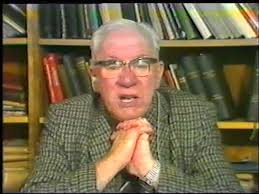

Recently I was reading about two very different people: William Barclay (whose works I have been familiar with since high school; inset left) and Wendy O. Williams (who I had never heard of until recently; inset right).
William Barclay was a preacher and teacher in the United Presbyterian Church in Scotland, famous for his Daily Study Bible series of commentaries. He was born in Scotland in 1907, flourished during the middle part of the century, and died a beloved family man in 1978. Though some of his theological views were quite liberal (he had problems with the Virgin Birth), he was a popular preacher of faith and morality and strove in his culturally conservative way to bring all men to Christ. Though I am not a great fan of his theology, I have always liked his word studies, and was reading a slim volume of his entitled, A New Testament Word Book containing a series of those word studies. More about this later.
On the same day I was also reading about Wendy O. Williams, whose life was included in a Facebook article about (of all things) suicide notes. Williams was an American singer born in 1949. At age 6 she did some tap dancing on the Howdy Doody television series as part of the “Peanut Gallery”. She was first arrested at the age of 15 for sunbathing nude. She left home at the age of 16, hitch-hiked to Colorado, and then went to Florida and to Europe where she began a series of jobs, including work as a lifeguard, a worker in “Dunkin Donuts”—and as a stripper. In 1976 she began work in New York doing a series of live sex shows. She became famous (Wikipedia tells me) for her singing career in a punk-rock band called “The Plasmatics”.
I confess I had never heard of the Plasmatics; my phone is full of the music of The Seekers, Gordon Lightfoot, and (don’t judge me) Olivia Newton-John. Wendy’s act was characterized by shocking lyrics and by the chain-sawing of guitars—and for wearing dramatically insufficient amounts of clothing on her upper torso. The inset photo of her next to William Barclay’s photo naturally does not attest to this latter characteristic. Some things you will have to Google for yourself. If you must.
Her outrageous and deliberately provocative sexual behaviour on stage got her in trouble a number of times, which included being charged with public obscenity. Her last public performance was in 1988, after which in 1991 she settled down in Connecticut with her partner and former manager, and worked as an animal rehabilitator and at a food co-op. She explained the move by saying she was “pretty fed up dealing with people”. She once described herself as a “marginal nymphomaniac and terminal exhibitionist” (which explains her interesting sense of fashion). Since 1966 she was also a committed vegetarian and was once featured on the cover of the Vegetarian Times. She gave up smoking, drinking, using drugs, and was opposed to the high amount of sugar used in processed food. She worked out, ran six miles a day, and refused to use products made by companies which used animals for lab testing.
She was also often depressed, and attempted suicide at least three times—once by hammering a knife into her sternum, once by drug overdose, and finally (and successfully) by shooting herself in 1998. She was then 48 years old. In the suicide note she left she said, “I don’t believe that people should take their own lives without deep and thoughtful reflection over a considerable period of time. I do believe strongly, however, that the right to do so is one of the most fundamental rights that anyone in a free society should have. For me, much of the world makes no sense, but my feelings about what I am doing ring loud and clear to an inner ear and a place where there is no self, only calm.”
One is tempted to say that if she had survived she would have been a poster girl for our modern culture, which is awash in pornography, loves vegetarianism, jogging, hates smoking and processed foods, and is adamant that people have the right to kill themselves for whatever reason. This last enthusiasm is cause for great alarm. I am reliably told that a person can now (in B.C. anyway) request a lethal injection one afternoon and be dead before suppertime. We now also believe strongly that the right of kill oneself is one of the most fundamental rights that anyone in a free society should have. If Wendy were here, she would doubtless applaud the rising ascendency of suicide-on-demand. Culturally speaking, she left us too soon.
Wendy is not just a poster child for our times, but is a mirror image of it. One can applaud her thoughtfulness and kindness to animals, and admire her habits such as healthy eating and jogging. But her defiance of sexual mores and her determination to shock are something else. The Greeks had a word for for it, and William Barclay shared what it was in his New Testament Word Book. It is a word that describes both Wendy and our current culture. It is ἀσέλγεια/ aselgeia. William further explains.
The word, he writes, “is used by Plato in the sense of ‘impudence’. …by a later writer as ‘preparedness for every pleasure’…it is described as ‘the spirit which knows no restraints and which dares whatever caprice and wonton insolence suggest’…the man in whose soul aselgeia dwells is so much in the grip of sin, so much under its domination, that he does not care what people say or think…he is the man who is lost to shame”.
That exactly describes both poor Wendy and our modern culture. How else to explain twerking—or Wendy O. Williams? As a people we are lost to shame; the moral bar has been slowly and gradually lowered to such a degree that what would have given our fathers and grandfathers cardiac arrest—things such as online porn, gay rights parades, the legal enshrinement of abortion as a sacred right, Drag Queens reading stories to the kiddies in public libraries, widespread gratuitous nudity in movies and television, and the glorification of sexual sado-masochism popularized by Fifty Shades of Grey—scarcely causes our hearts to beat faster. The point is not that these things are wrong. It is that as a culture the West has now lost its capacity to blush over anything. Aselgeia has us by the throat.
The moral of this comparison of William with Wendy? That we are currently living in a lunatic asylum, a house lost to shame and one that leads to spiritual suicide. We must now train our children and our catechumens to recognize this lunacy when they see it, and to embrace a counter-cultural sanity.
One last thing. I would ask that you light a candle for poor Wendy. I have no clue whether it will do her any good. But everyone should have at least one person who prays for them after they are gone. Those who were Wendy’s fans are unlikely to light Orthodox candles for her or commend her to the mercy of Christ. All the more reason for us to do so. And perhaps, if you are in a generous mood, light one for William as well.
